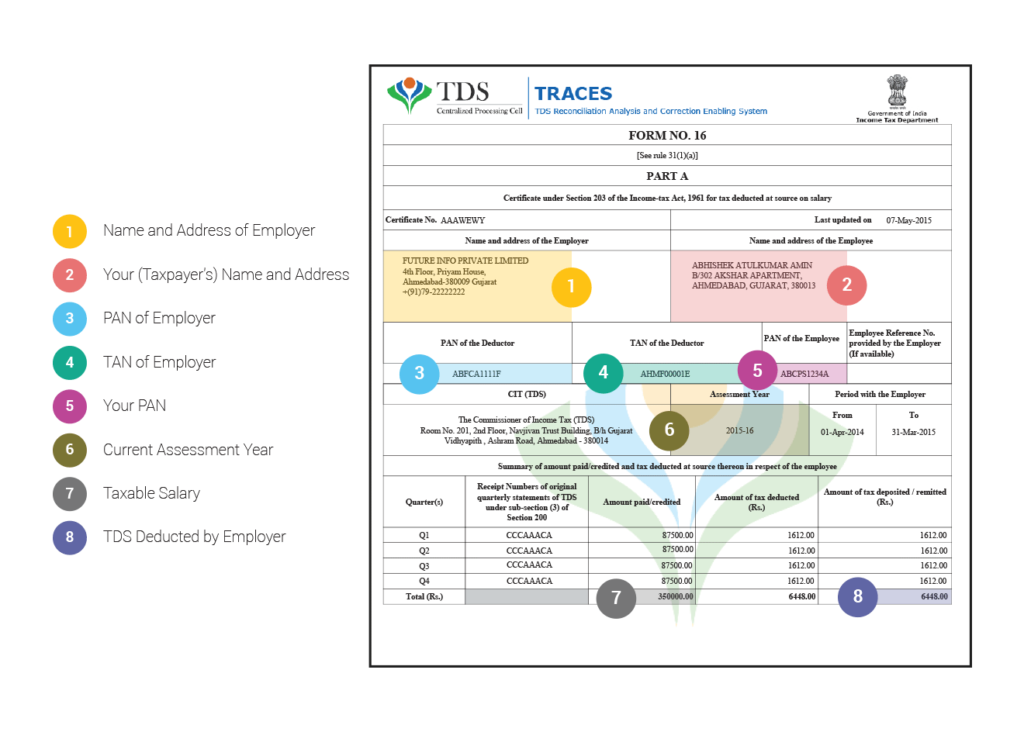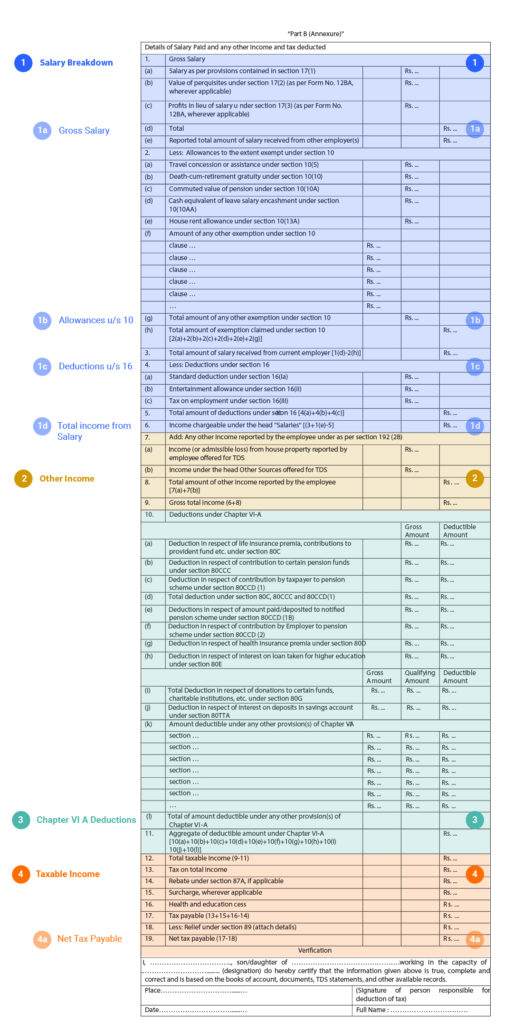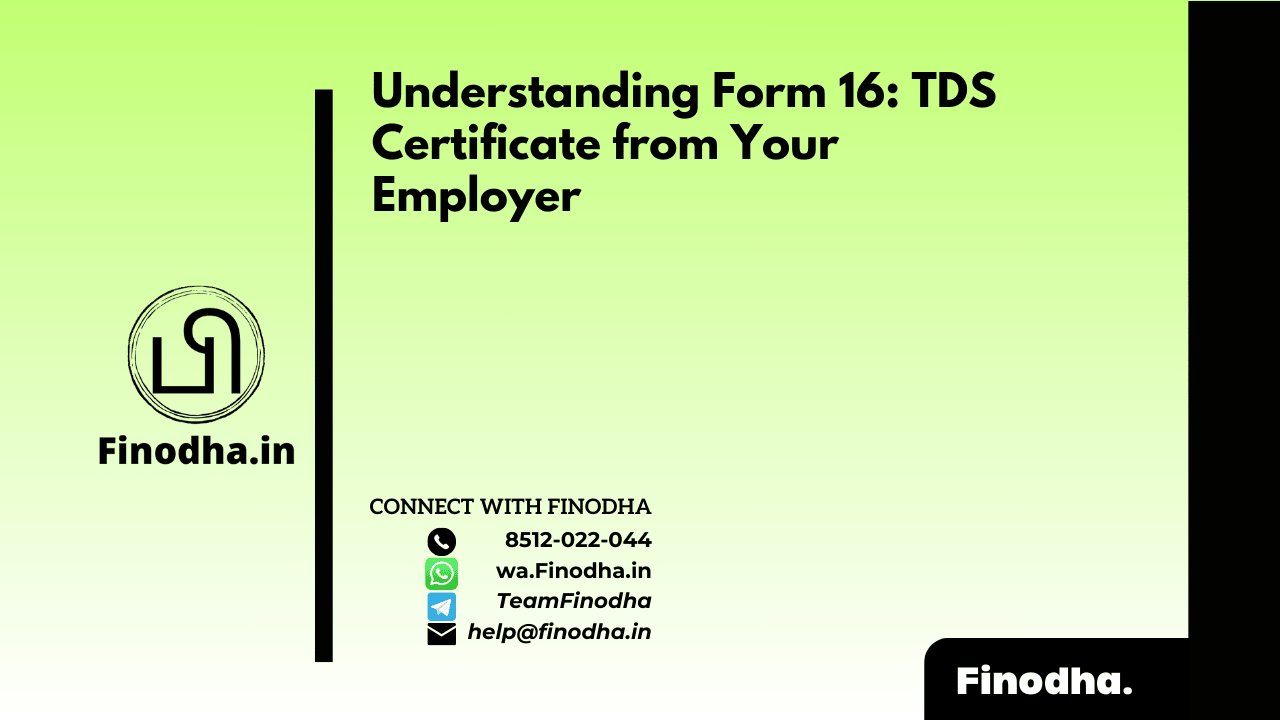Important Keywords: Form 16, Form 16A, Form 16B, TDS Certificate.
Words: 1,546; Read time: 8 minutes.
Table of Contents
Understanding Form 16: TDS Certificate from Your Employer
If you are an employee and receive a salary, you must have heard of Form 16. An essential document the employer issues to you every year depicting how much Tax Deducted at Source (TDS) has been deducted from the salary earned. Let’s break it down in simple terms so you can understand it better!
What is Form 16?
Form 16 – It is a Certificate of Tax Deduction Given by Your Employer Upon such a condition if you have accrued salary more than the basic exemption limit, your employer will begin to deduct tax on your behalf and give you proof of the amount deducted by the way of Form 16.
It is issued annually; generally, the due date for your employer to provide the same is the 15th of June after the end of the respective financial year. For example, during the financial year 2021-22, employers needed to issue Form 16 on or before 15th June 2022.
What’s New in Form 16?
From the financial year 2020-21, Part B of the form has been changed slightly but importantly. The form then seeks to know whether you are choosing the new tax regime given under Section 115BAC or opting out of it to opt old tax regime. You need to encircle ‘Yes’ or ‘No’ according to your choice to accept the new regime.

What Are the Two Components of Form 16?
Form 16 comprises two parts that are named the Part A and the Part B,
- Part A: This part consists of all information related to how much the employer has deducted, and deposited the tax to the government on your behalf. It comprises:
- The name, address, PAN, and TAN number of the employer
- Your name and PAN
- All the tax details deducted
Sample Form 16 – Part A

2. Part B: This breaks down your salary and you can see the following items therein:
Your gross salary or the total before all other deductions;
Allowances, including, among others, House Rent Allowance (HRA), and Leave Travel Allowance (LTA),
Deductions, which include among others, Standard Deduction, Professional Tax, and others, such as ELSS, or Life Insurance Premiums under Section 80C.
Form 16 – Part B

Why Does Everyone Need Form 16?
Form 16 otherwise turns out to be a savior while preparing and submitting your Income Tax Return (ITR). All the detailed information regarding your salary and TDS is available here, so it’s pretty easy to file. You can even cross-check with other forms like Form 26AS to see if the details actually match.
If, in any case, the employer does not provide you with Form 16, then you can either check the TDS credits in Form 26AS or consult with the employer.
How is your salary comprised in Form 16?
Part B of Form 16 is an Annexure to Part A. Part B is to be prepared by the employer for its employees and contains details of the breakup of salary and deductions approved under Chapter VI-A.
If you change your job in one financial year, you should take Form 16 from both employers. Some of the components of Part B notified newly are:
- Detailed breakup of salary
- Detailed breakup of exempted allowances under Section 10
- Deductions allowed under the Income Tax Act (under chapter VIA):
The list of deductions mentioned is as below:- Deduction for life insurance premium paid, contribution to PPF etc., under Section 80C
- Deduction for contribution to pension funds under Section 80CCC
- Deduction for employee’s contribution to a pension scheme under Section 80CCD(1)
- Deduction for taxpayer’s self-contribution to a notified pension scheme under Section 80CCD(1B)
- Deduction for employer’s contribution to a pension scheme under Section 80CCD(2)
- Deduction for health insurance premium paid under Section 80D
- Deduction for interest paid on loan taken for higher education under Section 80E
- Deduction for donations made under Section 80G
- Deduction for interest income on savings account under Section 80TTA.
- Tax calculated, surcharge, education and heath cess charged, relief under section 89.
Your total taxable income is accordingly worked out considering your allowances and deduction. The tax will be collected according to the prevailing tax slab applicable to you.
How can you use Form 16 to your advantage?
Form 16 also works as your ‘income from salary’ statement, which could be given by various authorities/ companies on demand.
Following are the uses of Form 16:
- Help in filing Income Tax Return
- Proof of income
- Document stating how your tax was computed and check any anomalies
- One place document to check all your tax-saving investments
- Loan assessment and approval
- Visa issuance
- On switching jobs: Helps the next employer compute your tax liabilities based on what your previous employer has already deducted
- Since the document is related to tax credit, you can check for any overpaid taxes, which will help you claim your refunds. if any
Frequently Asked Questions (FAQs)
-
What is Form 16, and why do I need it?
Form 16 is the TDS certificate issued by your employer, indicating how much tax has been withheld from your salary. It will guide you in preparing your income tax return accurately.
-
When will I receive Form 16?
You receive Form 16 by 15th June of every year from your employer. For example, if your financial year has ended in the year 2021-22, then you receive it by 15th June 2022.
-
What is Part A and what is Part B of Form 16
Part A is a summary of the TDS deducted by your employer. Part B is a detailed break-up of your salary, allowances, and deductions.
-
Can I file my ITR without Form 16?
You can file your ITR without Form 16 by using Form 26AS, which displays the credits of TDS. It is, however easier to file with Form 16 since it contains details of salary.
-
What shall I do if I have not received Form 16 from my employer?
If you do not receive Form 16, you can check your TDS credits in Form 26AS or contact your employer to issue the form.
-
If no Form 16 has been issued to me, does it mean I don’t have to pay tax or file a return?
While the onus of deducting tax on salaries and providing Form 16 is on the employer, the onus of paying income tax and filing an income tax return is on you. If your aggregate income from all sources exceeds the minimum tax slab, you must pay tax, whether or not your employer has deducted TDS. Even when he fails to issue you a Form 16, you must file an income tax return and pay off the due taxes.
-
What is the penalty for not furnishing Form 16 to the employer?
The employer will have to pay a sum of Rs. 500 per day for every day the default continues.
-
What should i do if there is error in my Form 16?
If you notice any discrepancies or errors in Form 16, immediately bring them to your employer’s attention.
-
My employer has deducted tax from my salary but has not issued me a Form 16, nor does my Form 26AS show any such deduction entries.
In such a case, it may be possible that your employer has deducted the tax from your salary but has not
deposited it to the credit of the Government account. You must pay the full tax amount while
filing your income tax return. Also, you should immediately bring this matter to your employer’s notice or
default.
Further, the employee should intimate the same to the Jurisdictional A.O., who may take appropriate action
for the same, and if the employer is found guilty, then carry out other further proceedings, including a levy
of penalty.
(As per Gujrat high court decision on 30/11/2021 in the case of Kartik Vijaysinh Sonavane v, DCIT – [2021], it
was held that TDS benefit would be given to the employee even in case TDS has not been deposited by
the employer)
Raed More: Form 16A: TDS on Income other than Salary
Web Stories: Form 16A: TDS on Income other than Salary
Official Income Tax Return filing website: https://incometaxindia.gov.in/




